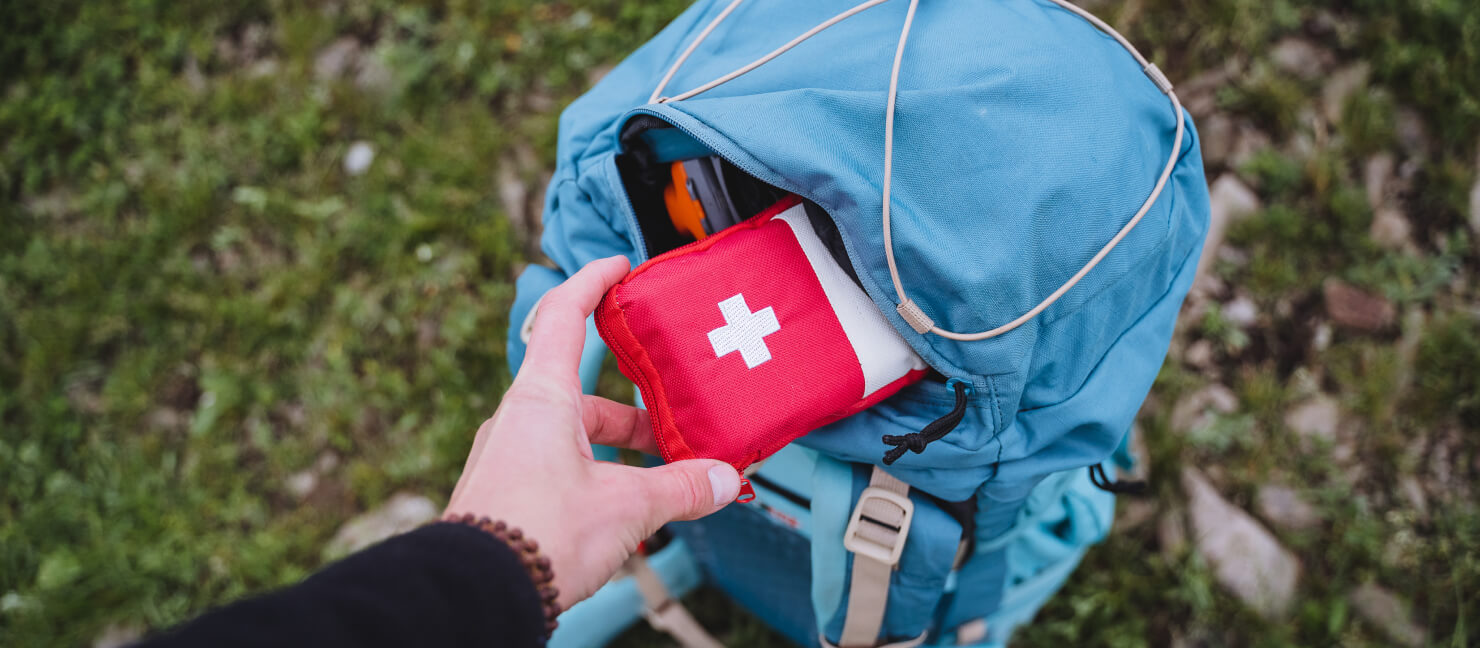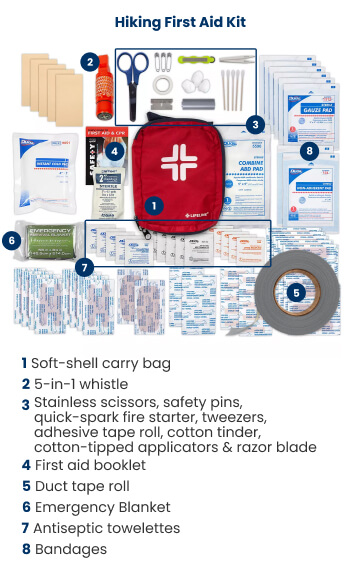Hiking Emergency? Discover What to Pack in Your First Aid Kit

Heading out on a long hike is an exhilarating experience, but nature can be quite unpredictable. Whether it's a minor scrape or an ankle sprain, being prepared is always a trailside essential! A pre-made first aid kit can save you time and ensure you've got all the necessary medical supplies.Keep reading to learn all about what your hiking first aid kit should include. This guide mostly focuses on day hiking adventures. Always be mindful of the duration of your hike among other factors like the expected terrain and how many people you hike with.
Key Takeaways
- Hiking First Aid Kit Contents: A good hiking first aid kit contains packing essentials like medications, bandages, braces, flares, antacids, a CPR mask, throat lozenges, and more.
- Hiking First Aid Kit Options: Start building your first aid kit with essential items like bandages and pain relievers. Always opt for a pre-made kit that can accommodate your whole hiking group.
- How to Restock Your First Aid Kit for Hiking: After each hike (or at least once a month), restock your kit. Replace bandages, pain relievers, and other frequently used items to stay prepared.
- What Not to Include in Your Hiking Emergency Kit: Don’t include expired medication, super glue, and a tourniquet in your hiking emergency kit. Stick to the essentials for a safer and more effective kit.
- Hiking First Aid Kit Contents Recap: Save our infographic to your phone before you head out to stock up on all the first aid essentials.
- Frequently Asked Questions: Get answers to your backpacking questions like “Why is a hiking knife important?” and more.
Hiking First Aid Kit Contents
Your hiking first aid kit is your lifeline — especially in the most remote areas. From tending to minor scrapes to addressing emergencies like sprained wrists, a well-stocked kit is essential. Learn how to use every item in your kit before your hike. We categorized the must-have hiking first aid kit contents into 6 sections for you:

Basic First Aid Supplies
-
Bandaids (variety of sizes)
-
Gauze Pads
-
Non Stick Sterile Pads
-
Antibiotic Ointment
-
Antiseptic Wipes
-
Butterfly Stitches
-
Steri-Strips
-
Itch Stopping Cream
-
Anti-Chafe Cream
Medications
-
Prescription Medications
-
Allergy Relief
-
Pain Relief
-
Antacids
-
Anti-Diarrheal
Bandages + Wound Care
-
Compression Wrap + Safety Pins
-
Triangle Bandage
-
Finger Splint(s)
-
SAM Splint(s)
-
Rolled Gauze
-
Hydrogel-Based Pads
-
Liquid Bandage
-
Ankle and Knee Brace
-
Irrigation Syringe (for cleaning wounds)
Life-Saving Equipment
-
Injectable Epinephrine (for severe allergic reactions — if prescribed)
-
Glucose or Other Sugar/Snack (to treat hypoglycemia — if prescribed)
-
CPR Mask
-
Hemostatic (blood-stopping) Gauze
-
Oral Rehydration Salts (to prevent dehydration)
Additional Items
-
Chapstick
-
Throat Lozenges
-
Eyedrops
-
Sports Tape/Medical Tape
-
Tampon (for nosebleeds or intended use)
-
Cotton Swabs
Hiking First Aid Kit Options
When it comes to hiking first aid kits, you have options. You can either purchase a ready-made kit or build a custom first aid kit. Learn how to choose the right premade kit for your needs.

How To Choose a Premade First Aid Kit
Opting for a premade first aid kit can be a cost-effective and time-saving choice. These kits are designed to cover the basics. This makes them perfect for those last-minute trips when crafting a personalized kit just isn't feasible.
-
Size: Premade first aid kits are available in various sizes. For day trips with 1-2 people, a smaller kit should suffice. For larger hiking groups, consider choosing a kit with 100 or 200 pieces.
-
Hiking Location: Tailor your first aid kit to the specific challenges of your hiking environment. If you’re hiking in snake territory, then be sure to shop for a snake bite kit. For challenging trails, consider a trauma care kit designed for rapid bleeding control.
-
Special Additions: Customize your premade kit to cater to the unique needs of your group members. For someone with diabetes, consider adding crackers to manage low blood sugar. Don't forget to pack prescription medications or essentials like an Epi-Pen.
How To Build a First Aid Kit
Building a first aid kit for hiking takes proper planning. Prioritize selecting the appropriate bag size for your kit, curating the right medical supplies, and arranging them for quick access.
-
First Aid Kit Bag: You can repurpose an old first aid kit or invest in a new bag. Pick the appropriate size bag for your kit. If you plan on storing your kit inside your backpack, purchase a backpack cover to protect your kit from the elements.
-
Essentials First: Stock up on basics like antibiotic ointment, bandaids, and a range of medications for pain, stomach relief, and headaches. Don't forget specialized items like an emergency blanket, thermometer, and safety scissors.
-
Stay Organized: Utilize plastic bags, pill bottles, and markers for labeling. Ensure each compartment is arranged for easy access. This will ensure your items stay in place when opened.

How to Restock Your First Aid Kit for Hiking
Keeping your hiking first aid kit well-stocked is essential for safety on the trails. Regularly check and replenish items to ensure you're always prepared for any situation.
-
Replenish Regularly: Check your kit's inventory regularly and head to your local pharmacy or drugstore for refills. Prioritize replacing items like finger bandages, painkillers, and any expired medications.
-
Post-Hike Refills: After each hike, replenish any used items. This is especially important if you're hiking with accident-prone companions.
-
Monthly Refills: For those who hike less frequently, a comprehensive restock once a month is advisable. This ensures your kit remains up-to-date and ready for use.
Expert Tip:
Store your first aid kit in a dry or waterproof bag to keep it from getting damp. A waterproof bag has several compartments for organization. Plastic baggies are prone to tearing — making a dry bag the more durable choice.
What Not to Include in Your Hiking Emergency Kit
When packing for a hike, every ounce counts. Avoid adding unnecessary weight to your first aid kit by being selective with its contents. Consider excluding the following items:
-
Expired medications
-
Highly specialized items
-
Suture kits (usually, stopping the bleeding and seeking professional care is better)
-
Tourniquets (primarily for warzones)
-
Superglue (not suitable for skin application)
Expert Tip:
For safety during your travels and in daily life — think about investing in an emergency road kit. These kits not only include first aid essentials but also items like jumper cables, ponchos, and batteries for added peace of mind on the road.
Hiking First Aid Kit Contents Recap
One moment you’re navigating a rocky trail — and the next your knee is bleeding profusely. For any unexpected incidents, having a hiking emergency kit is essential. Ensure your hiking first aid kit is stocked with the basic essentials: band-aids, gauze, scissors, an emergency blanket, and tweezers.

Frequently Asked Questions
What Should a Hikers First Aid Kit Contain?
Your first aid kit should be equipped to handle minor cuts and injuries. Essential items include gauze, bandages, antibiotic cream, medical tape, and scissors. Ensure you can clean and treat wounds with antiseptic wipes. Don't forget crucial additions like a space blanket and a CPR mask.
How to Build a Backcountry First Aid Kit?
For extended hiking or backpacking trips, your first aid kit should be more comprehensive. Along with basic supplies, stock it with prescription medications, remedies for diarrhea and chafing, and electrolyte replacements.
Why Is a Hiking Knife Important?
A hiking knife is a versatile tool on the trail. It can efficiently cut gauze and bandages. It's useful for slicing through clothing or even crafting an emergency tourniquet.
Have Fun Out There!
Don't let a trail injury dampen your hiking spirit! Assemble your first aid kit or explore our curated selection. Equip yourself with essentials like bandages and gauze to confidently handle any mishaps on the trail.


